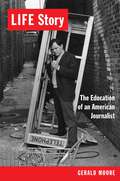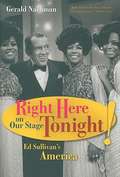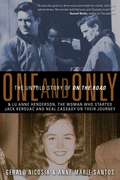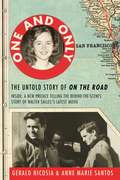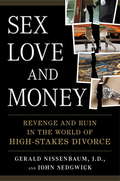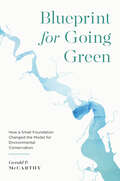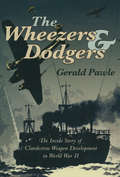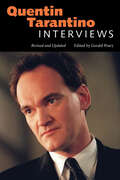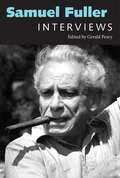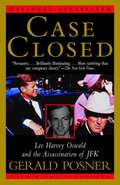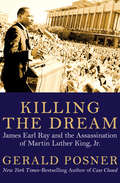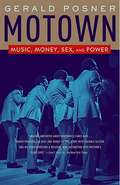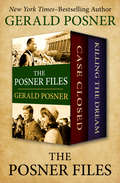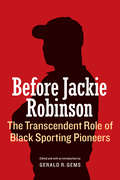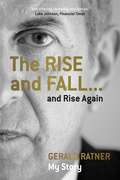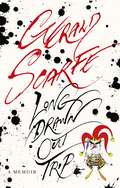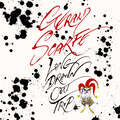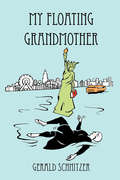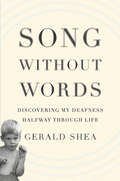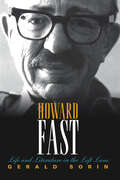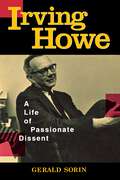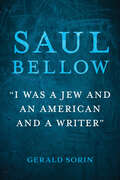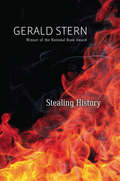- Table View
- List View
LIFE Story: The Education of an American Journalist
by Gerald MooreBefore Americans got their news from television, they got it from LIFE, the weekly magazine that set the standard for photojournalism. In LIFE Story Gerald Moore—a writer and editor who worked at the magazine in the last glory years before TV made it obsolete—recalls the dizzying excitement and glamour of LIFE&’s fast-moving, powerful approach to spreading the news. Moore covered the major stories of the late 1960s and early 1970s: LSD, assassinations, the 1968 Democratic convention in Chicago, the McCarthy campaign, urban riots, the My Lai massacre, and the beginnings of feminism. Before joining LIFE at the age of twenty-seven, he worked as a police officer in Albuquerque and then a reporter at the Albuquerque Tribune—both jobs teaching him the tools of his trade. His story offers a wonderful look back at the good and the bad old days of journalism.
Right Here on Our Stage Tonight!: Ed Sullivan's America
by Gerald NachmanThis book explores the transcendent Sullivan experience through the eyes of some 75 performers--famous, infamous, and long forgotten--who appeared on the show.
One and Only: The Untold Story of On the Road
by Gerald NicosiaBeloved by both Jack Kerouac and Neal Cassady, Lu Anne Henderson's story has never been told. Lu Anne was a beautiful 15-year-old girl in Denver in 1945 when she met Neal, a fast-talking hurricane of male sexuality and vast promises. The two married, and soon they were hanging out with a group of would-be writers, including Jack Kerouac and Allen Ginsberg. But Neal and Jack initially didn't like each other very much. Lu Anne taught them how to love each other -- in effect, making the Beat Generation possible, as well as giving Kerouac material for one of the seminal novels of the 20th century, On the Road. One and Only traces the immense struggles of Lu Anne's own life, which ranged from the split-up of her family to the ravages of abusive men, lingering illness, and the grief of losing the two most important men in her life. Lu Anne Henderson did not live to see the filming of On the Road by Walter Salles, but One and Only tells how Twilight's Kristen Stewart, through her work with both Nicosia and Anne Marie Santos (Lu Anne's daughter), came to find the key to playing Lu Anne in the film.
One and Only: The Untold Story of On the Road and LuAnne Henderson, the Woman Who Started Jack Kerouac and Neal Cassady on Their Journey
by Gerald NicosiaBeloved by both Jack Kerouac and Neal Cassady, Lu Anne Henderson has never told her story. Lu Anne was a beautiful 15-year-old girl in Denver in 1945 when she met Neal, a fast-talking hurricane of male sexuality. The two married, and soon they were hanging out with a group of young would-be writers, including Jack Kerouac and Allen Ginsberg. But Neal and Jack initially didn't like each other. Lu Anne ended up loving them both, and she taught them how to love each other -- giving Kerouac material for one of the seminal novels of the 20th century, On the Road. One and Only traces the immense struggles of Lu Anne's life, from the split-up of her family during the Great Depression to the ravages of abusive men and a late-life heroin addiction. It shows how her life intertwined with Jack's and Neal's to the very end.
Sex, Love, and Money
by John Sedgwick Gerald NissenbaumOne of the nation's top divorce lawyers opens his case files to share true stories that rival the most outrageous fiction Gerald Nissenbaum knows everything about his clients-how much is in their bank accounts, what kind of sex their spouses like, if they married for money or power, and who cheated with whom. For the first time in his long career, Nissenbaum gives the lowdown on all the antics he's experienced in dealing with clients who have money to burn. From a C-note hooker-turned-trophy-wife who put her dying husband into a nursing home and drained his bank accounts, to the dad who spent millions to recover the kids his wife kidnapped, this memoir is by turns dark, cathartic, vengeful, and hilarious as it describes the high-end, high-conflict divorces that ruin the lives of everyone involved. Currently commanding $700 per hour, Nissenbaum sees firsthand how neurotic, unrealistic, status-hungry, manipulative, and sex-crazed his multimillion-dollar clients can be. In the style of Anthony Bourdain's Kitchen Confidential, Nissenbaum and Sedgwick blow the doors off the dark side of marriage, making this outrageous and compelling memoir a truly guilty pleasure.
Blueprint for Going Green: How a Small Foundation Changed the Model for Environmental Conservation
by Gerald P. McCarthyHow one organization took on industrial pollution—and the lessons for our new century In 1977, one forward-thinking judge took an ecological disaster—the poisoning of the James River by Allied Chemical—and turned it into a great environmental-protection legacy. The $8 million payment made by Allied would go on to fund the game-changing Virginia Environmental Endowment.Blueprint for Going Green provides an insider&’s account of the remarkable results of this landmark ruling and the foundation it spawned. Over the following decades, the VEE helped to grow the fledgling environmental movement in Virginia into a powerful force for protecting the state&’s water quality and conserving its landscape. This inspiring story reveals how a small group can make a profound difference by engaging in public policy work, funding science to advance public policy, and helping to build a lasting and effective citizen-led environmental movement. Finalist for the Southern Environmental Law Center's Phillip D. Reed Environmental Writing Award
The Wheezers & Dodgers: The Inside Story of Clandestine Weapon Development in World War II
by Gerald PawleA rare look inside the Department of Miscellaneous Weapon Development, &“a fascinating report on the trials—and some tribulations—of a clandestine world&” (Kirkus Reviews). Previously published under the title The Secret War 1939-1945, this is a firsthand account of the Admiralty&’s Department of Miscellaneous Weapon Development, the so-called &“Wheezers and Dodgers,&” and the many ingenious weapons and devices it invented, improved or perfected. Gerald Pawle was one of a group of officers with engineering or scientific backgrounds who were charged with the task of winning the struggle for scientific mastery between the Allies and the Germans in what Churchill enthusiastically called &“the wizard war.&” Their work ranged from early stop-gap weapons like the steam-powered Holman projector, via great success stories like the Hedgehog anti-submarine mortar, to futuristic experiments with rockets, a minefield that could be sown in the sky, and the spectacularly dangerous Great Panjandrum, a giant explosive Catherine-wheel intended to storm enemy beaches. The development of these and many other extraordinary inventions, their triumphs and disasters, is told with panache and humor by Pawle, and a diverse group of highly imaginative and eccentric figures emerge from the pages.
Quentin Tarantino: Interviews, Revised and Updated (Conversations with Filmmakers Series)
by Gerald PearyHere, in his own colorful, slangy words, is the true American Dream saga of a self-proclaimed "film geek," with five intense years working in a video store, who became one of the most popular, recognizable, and imitated of all filmmakers. His dazzling, movie-informed work makes Quentin Tarantino's reputation, from his breakout film, Reservoir Dogs (1992), through Kill Bill: Vol. 1 (2003) and Kill Bill: Vol. 2 (2004), his enchanted homages to Asian action cinema, to his rousing tribute to guys-on-a-mission World War II movie, Inglourious Basterds (2009). For those who prefer a more mature, contemplative cinema, Tarantino provided the tender, very touching Jackie Brown (1997). A masterpiece--Pulp Fiction (1994). A delightful mash of unabashed exploitation and felt social consciousness--his latest opus, Django Unchained (2012).From the beginning, Tarantino (b. 1963)--affable, open, and enthusiastic about sharing his adoration of movies--has been a journalist's dream. Quentin Tarantino: Interviews, revised and updated with twelve new interviews, is a joy to read cover to cover because its subject has so much interesting and provocative to say about his own movies and about cinema in general, and also about his unusual life. He is frank and revealing about growing up in Los Angeles with a single, half-Cherokee mother, and dropping out of ninth grade to take acting classes. Lost and confused, he still managed a gutsy ambition: young Quentin decided he would be a filmmaker.Tarantino has conceded that Ordell (Samuel L. Jackson), the homicidal African American con man in Jackie Brown, is an autobiographical portrait. "If I hadn't wanted to make movies, I would have ended up as Ordell," Tarantino has explained. "I wouldn't have been a postman or worked at the phone company. . . . I would have gone to jail."
Samuel Fuller: Interviews (Conversations with Filmmakers Series)
by Gerald PearyIn the early twentieth century, the art world was captivated by the imaginative, original paintings of Henri Rousseau, who, without formal art training, produced works that astonished not only the public but great artists such as Pablo Picasso. Samuel Fuller (1912–1997) is known as the “Rousseau of the cinema,” a mostly “B” genre Hollywood moviemaker deeply admired by “A” filmmakers as diverse as Jim Jarmusch, Martin Scorsese, Francois Truffaut, Jean-Luc Godard, and John Cassavetes, all of them dazzled by Fuller’s wildly idiosyncratic primitivist style. A high school dropout who became a New York City tabloid crime reporter in his teens, Fuller went to Hollywood and made movies post-World War II that were totally in line with his exploitative newspaper work—bold, blunt, pulpy, excitable. The images were as shocking, impolite, and in-your-face as a Weegee photograph of a gangster bleeding on a sidewalk. Fuller, who made twenty-three features between 1949 and 1989, is the very definition of a “cult” director, appreciated by those with a certain bent of subterranean taste, a penchant for what critic Manny Farber famously labeled as “termite art.” Here are some of the crazy, lurid, comic book titles of his movies: Shock Corridor, The Naked Kiss, Verboten!, and Pickup on South Street. Fuller isn’t for everybody. His fans have to appreciate low-budget genre films, including westerns and war movies, and make room for some hard-knuckle, ugly bursts of violence. They also have to make allowance for lots of broad, crass acting, and scripts (all Fuller-written) that can be stiff, sometimes campy, often laboriously didactic. Fuller is for those who love cinema—images that jump, shout, and dance. As he put it in his famous cigar-chomping cameo, acting in Jean-Luc Godard’s Pierrot le fou (1965): “Film is like a battleground . . . love, hate, violence, death. In a single word: emotion.” After directing, Fuller's greatest skill was conversation. He could talk, talk, talk, from his amazing experiences fighting in World War II to the time his brother-in-law dated Marilyn Monroe, and vivid stories about his moviemaking. Samuel Fuller: Interviews is not only informative about the filmmaker’s career but sheer fun, following the wild, uninhibited stream of Fuller’s chatter. He was an incredible storyteller, and no matter what the interview was, he had stories galore for all sorts of readers, not just for academics and film historians.
Case Closed: Lee Harvey Oswald and the Assassination of JFK
by Gerald PosnerThe assassination of John F. Kennedy on November 22, 1963, continues to inspire interest ranging from well-meaning speculation to bizarre conspiracy theories and controversial filmmaking. But in this landmark book,reissued with a new afterword for the 40th anniversary of the assassination, Gerald Posner examines all of the available evidence and reaches the only possible conclusion: Lee Harvey Oswald acted alone. There was no second gunman on the grassy knoll. The CIA was not involved. And although more than four million pages of documents have been released since Posner first made his case, they have served only to corroborate his findings. Case Closedremains the classic account against which all books about JFK's death must be measured.
Killing the Dream: James Earl Ray and the Assassination of Martin Luther King, Jr.
by Gerald PosnerA deep dive into James Earl Ray&’s role in the national tragedy: &“Superb . . . a model of investigation . . . as gripping as a first-class detective story&” (The New York Times). On April 4, 1968, Martin Luther King Jr. was killed in Memphis, Tennessee, by a single assassin&’s bullet. A career criminal named James Earl Ray was seen fleeing from a rooming house that overlooked the hotel balcony from where King was cut down. An international manhunt ended two months later with Ray&’s capture. Though Ray initially pled guilty, he quickly recanted and for the rest of his life insisted he was an unwitting pawn in a grand conspiracy. In Killing the Dream, expert investigative reporter Gerald Posner reexamines Ray and the evidence, even tracking down the mystery man Ray claimed was the conspiracy&’s mastermind. Beginning with an authoritative biography of Ray&’s life, and continuing with a gripping account of the assassination and its aftermath, Posner cuts through phony witnesses, false claims, and a web of misinformation surrounding that tragic spring day in 1968. He puts Ray&’s conspiracy theory to rest and ultimately manages to disclose what really happened the day King was murdered.
Motown: Music, Money, Sex, and Power
by Gerald PosnerIn 1959, twenty-nine-year-old Berry Gordy, who had already given up on his dream to be a champion boxer, borrowed eight hundred dollars from his family and started a record company. A run-down bungalow sandwiched between a funeral home and a beauty shop in a poor Detroit neighborhood served as his headquarters. The building's entrance was adorned with a large sign that improbably boasted "Hitsville U. S. A. " The kitchen served as the control room, the garage became the two-track studio, the living room was reserved for bookkeeping, and sales were handled in the dining room. Soon word spread that any youngster with a streak of talent should visit the only record label that Detroit had seen in years. The company's name was Motown. Motown cuts through decades of unsubstantiated rumors and speculation to tell the true behind-the-scenes narrative of America's most exciting musical dynasty. It follows the company and its amazing roster of stars from the tumultuous growth years in Detroit, to the drama and intrigue of Hollywood in the 1970s, to resurgence in 2002. Set against the civil rights movement, the decay of America's northern industrial cities, and the social upheaval of the 1960s, Motown is a tale of the incredible entrepreneurship of Berry Gordy. But it also features the moving stories of kids from Detroit's inner-city projects who achieved remarkable success and then, in many cases, found themselves fighting the demons that so often come with stardom--drugs, jealousy, sexual indulgence, greed, and uncontrollable ambition. Motown features an extraordinary cast of characters, including Diana Ross, Michael Jackson, Marvin Gaye, Smokey Robinson, and Stevie Wonder. They are presented as they lived and worked: a clan of friends, lovers, competitors, and sometimes vicious foes. Motown reveals how the hopes and dreams of each affected the lives of the others and illustrates why this singular story is a made-in-America Greek tragedy, the rise and fall of a supremely talented yet completely dysfunctional extended family. Based on numerous original interviews and extensive documentation, Motown benefits particularly from the thousands of pages of files crammed into the basement of downtown Detroit's Wayne County Courthouse. Those court records provide the unofficial--and hitherto largely untold--history of Motown and its stars, since almost every relationship between departing singers, songwriters, producers, and the label ended up in litigation. From its peaks in the late 1960s and early 1970s, when Motown controlled the pop charts and its stars were sought after even by the Beatles, through the inexorable slide caused by their failure to handle their stardom, Motown is a riveting and troubling look inside a music label that provided the unofficial soundtrack to an entire generation. From the Hardcover edition.
The Posner Files: Case Closed and Killing the Dream
by Gerald PosnerDefinitive accounts of JFK&’s and Martin Luther King&’s assassinations by a Pulitzer Prize finalist and New York Times–bestselling author. Case Closed: A Pulitzer Prize finalist and New York Times bestseller, Case Closed is a vivid and straightforward account that stands as one of the most authoritative books on the assassination of John F. Kennedy. Drawing from official sources and dozens of interviews, filled with powerful historical detail, and including an updated comment for the fiftieth anniversary, Posner&’s &“utterly convincing&” book lays to rest all of the convoluted conspiracy theories—concerning the mafia, a second shooter, and the CIA—that have obscured what really happened in Dealey Plaza on November 22, 1963 (Chicago Tribune). &“By far the most lucid and compelling account . . . of what probably did happen in Dallas—and what almost certainly did not.&” —The New York Times Book Review Killing the Dream: On April 4, 1968, Martin Luther King Jr., was killed in Memphis, Tennessee, by a single assassin&’s bullet. James Earl Ray was seen fleeing from a rooming house that overlooked the hotel balcony where King was shot. An international manhunt ended two months later with Ray&’s capture. Though Ray initially pled guilty, he quickly recanted and for the rest of his life insisted he was an unwitting pawn in a grand conspiracy. In Killing the Dream, expert investigative reporter Gerald Posner cuts through phony witnesses, false claims, and a web of misinformation to put Ray&’s conspiracy theory to rest and disclose what really happened the day King was murdered. &“A superb book: a model of investigation, meticulous in its discovery and presentation of evidence, unbiased in its exploration of every claim. And it is a wonderfully readable book, as gripping as a first-class detective story.&” —The New York Times
Before Jackie Robinson: The Transcendent Role of Black Sporting Pioneers
by Gerald R. GemsWhile the accomplishments and influence of Jack Johnson, Joe Louis, Jesse Owens, Jackie Robinson, and Muhammad Ali are doubtless impressive solely on their merits, these luminaries of the black sporting experience did not emerge spontaneously. Their rise was part of a gradual evolution in social and power relations in American culture between the 1890s and 1940s that included athletes such as jockey Isaac Murphy, barnstorming pilot Bessie Coleman, and golfer Teddy Rhodes. The contributions of these early athletes to our broader collective history, and their heroic confrontations with the entrenched racism of their times, helped bring about the incremental changes that after 1945 allowed for sports to be more fully integrated.Before Jackie Robinson details and analyzes the lives of these lesser-known but important athletes within the broader history of black liberation. These figures not only excelled in their given sports but also transcended class and racial divides in making inroads into popular culture despite the societal restrictions placed on them. They were also among the first athletes to blur the line between athletics, entertainment, and celebrity culture. This volume presents a more nuanced account of early African American athletes’ lives and their ongoing struggle for acceptance, relevance, and personal and group identity.
The Rise and Fall...and Rise Again: The Rise And Fall... And Rise Again
by Gerald RatnerIn 1991, Gerald Ratner made a landmark speech to the Institute of Directors After over 25 years in the jewellery trade, Gerald Ratner was one of the most well-known and successful retailers of his generation. He had built up a highly profitable, multi-million pound international business, including household names like Ratners, H Samuel, Ernest Jones, Watches of Switzerland, as well as over one thousand stores in the US. Being asked to give the keynote address at the Institute of Directors' annual conference at The Royal Albert Hall was a great honour and should have been the crowning glory on two decades of empire building. Gerald's speech was seized upon by the media after he included jokes about the quality of some of the shops' products. But the far-reaching impact that these jokes would have no one could have predicted. "Even though I had once had my name above hundreds of shops up and down the country, it had become more famous as a byword for crap. It took several years to realise just what an impact the speech had had on every aspect of my life." Press coverage of hardback version: "... a rollicking good read" —Michael Skapinker, The FT "Most business autobiographies are so overlaid with ghost-writerly blandness that the character of the subject is lost. Mr Ratner had help with this one, but fortunately he is still there: obsessive, funny and a bit of a scoundrel - the last mitigated by how well he knows it." —The FT "self-effacing, revealing and human" —Luke Johnson, FT Business Life "A few ill-chosen words to a well-heeled audience 16 years ago reduced Britain's biggest jeweller to poverty. Now he reveals how he bounced back" —Jewish Chronicle "...contains lessons for us all" —Management Today "...worth its weight in gold" —The Independent Amazon reviews "Everyone knows the story of Gerald's rise and fall - what an amazing story and well worth reading.... I couldn't put it down, totally gripping and inspiring stuff, you really couldn't see this coming from such an energetic, passionate man" "I have read many bio's from business leaders and most are boring 'how to get rich' or 'let me tell you a long list of not very interesting stories with all the good bits missed out'. Gerald's book is very different it is a great read, I could not put it down" "Sobering and enlightening at the same time. A great read and a morality tale of our time."
Long Drawn Out Trip: A Memoir
by Gerald ScarfeIn Long Drawn Out Trip: My Life, Gerald Scarfe tells his life story for the first time. With captivating, often thrilling stories, he takes us from his childhood and early days at Punch and Private Eye, through his long and occasionally tumultuous career as the Sunday Times cartoonist, to his film-making at the BBC and much-loved designs for Pink Floyd's The Wall and Disney's Hercules. Along the way he has drawn Churchill from life, gone on tour with The Beatles and thoroughly upset Mrs Mary Whitehouse. It is a very personal, wickedly funny and caustically insightful account of an artist's life at the forefront of contemporary culture and society.
Long Drawn Out Trip: A Memoir
by Gerald ScarfeIn Long Drawn Out Trip: My Life, Gerald Scarfe tells his life story for the first time. With captivating, often thrilling stories, he takes us from his childhood and early days at Punch and Private Eye, through his long and occasionally tumultuous career as the Sunday Times cartoonist, to his film-making at the BBC and much-loved designs for Pink Floyd's The Wall and Disney's Hercules. Along the way he has drawn Churchill from life, gone on tour with The Beatles and thoroughly upset Mrs Mary Whitehouse. It is a very personal, wickedly funny and caustically insightful account of an artist's life at the forefront of contemporary culture and society.
Long Drawn Out Trip: A Memoir
by Gerald ScarfeIn 1964 a young artist sat in the public gallery of the House of Commons, sketching former Prime Minister Winston Churchill. The Sunday Times refused to print the resulting drawing of this frail, aged figure - so far from the public image of the man - it was too truthful.In the sixty years since, Gerald Scarfe's work has continued to expose the truth, and has appeared many times in the pages of the Sunday Times, in the Evening Standard, New Yorker, Private Eye and Time, as well as on the walls of the V&A and the Tate, the stages of the English National Opera and the English National Ballet, and cinema screens around the world in the form of Pink Floyd The Wall and Disney's Hercules.In Long Drawn Out Trip, Gerald tells his life story for the first time. With captivating, often thrilling stories, he takes us back to his wartime childhood and the terrible curse of asthma, through his days as an advertising draughtsman, to his field reporting in Vietnam and the giddy highs of rock 'n' roll. He also reveals the process of cartooning - and the ways that certain subjects have reacted to his visions of them. Along the way he has been car-jacked in Derry, dined with royals, and thoroughly upset Mrs Mary Whitehouse. It is a very personal, wickedly funny and caustically insightful account of an artist's life at the forefront of contemporary culture and society.
My Floating Grandmother
by Gerald SchnitzerPanic was a permanent guest in the Schnitzer's home during the 1920s. They celebrated life, but never in moderation. Thanks to Gerald's grandmother acting as a traffic cop on an emotional oasis, order was restored. Before her death, Grandma Sarah discovered the calming waters off Coney Island. She never learned to swim, not a stroke, but she could float, sometimes out of sight of land - but that's another story.
Song Without Words: Discovering My Deafness Halfway through Life
by Gerald Shea<P>Much has been written about the profoundly deaf, but the lives of the nearly 30 million partially deaf people in the United States today remain hidden. Song without Words tells the astonishing story of a man who, at the age of thirty-four, discovered that he had been deaf since childhood, yet somehow managed to navigate his way through Andover, Yale, and Columbia Law School, and to establish a prestigious international legal career. <P>Gerald Shea's witty and candid memoir of how he compensated for his deafness--through sheer determination and an amazing ability to translate the melody of vowels. His experience gives fascinating new insight into the nature and significance of language, the meaning of deafness, the fierce controversy between advocates of signing and of oral education, and the longing for full communication that unites us all.
Howard Fast: Life and Literature in the Left Lane (The\modern Jewish Experience Ser.)
by Gerald SorinHoward Fast's life, from a rough-and-tumble Jewish New York street kid to the rich and famous author of close to 100 books, rivals the Horatio Alger myth. Author of bestsellers such as Citizen Tom Paine, Freedom Road, My Glorious Brothers, and Spartacus, Fast joined the American Communist Party in 1943 and remained a loyal member until 1957, despite being imprisoned for contempt of Congress. Gerald Sorin illuminates the connections among Fast's Jewishness, his writings, and his left-wing politics and explains Fast's attraction to the Party and the reasons he stayed in it as long as he did. Recounting the story of his private and public life with its adventure and risk, love and pain, struggle, failure, and success, Sorin also addresses questions such as the relationship between modern Jewish identity and radical movements, the consequences of political myopia, and the complex interaction of art, popular culture, and politics in 20th-century America.
Irving Howe: A Life of Passionate Dissent
by Gerald SorinA New York Times “Books for Summer Reading” selectionWinner of the 2003 National Jewish Book Award for HistoryBy the time he died in 1993 at the age of 73, Irving Howe was one of the twentieth century’s most important public thinkers. Deeply passionate, committed to social reform and secular Jewishness, ardently devoted to fiction and poetry, in love with baseball, music, and ballet, Howe wrote with such eloquence and lived with such conviction that his extraordinary work is now part of the canon of American social thought.In the first comprehensive biography of Howe’s life, historian Gerald Sorin brings us close to this man who rose from Jewish immigrant poverty in the 1930s to become one of the most provocative intellectuals of our time. Known most widely for his award-winning book World of Our Fathers, a rich portrayal of the East European Jewish experience in New York, Howe also won acclaim for his prodigious output of illuminating essays on American culture and as an indefatigable promoter of democratic socialism as can be seen in the pages of Dissent, the journal he edited for nearly forty years.Deeply devoted to the ideal of democratic radicalism and true equality, Howe was constantly engaged in a struggle for decency and basic fairness in the face of social injustice. In the century of Auschwitz, the Gulag, and global inter-ethnic mass murder, it was difficult to sustain political certainties and take pride in one's humanity. To have lived a life of conviction and engagement in that era was a notable achievement. Irving Howe lived such a life and Gerald Sorin has done a masterful job of guiding us through it in all its passion and complexity.
Saul Bellow: "I Was a Jew and an American and a Writer" (The Modern Jewish Experience)
by Gerald SorinSaul Bellow: "I Was a Jew and an American and a Writer" offers a fresh and original perspective on the life and works of Saul Bellow, the Nobel Prize winner in Literature in 1976. Author Gerald Sorin emphasizes Bellow's Jewish identity as fundamental to his being and the content and meaning of his fiction. Bellow's work from the 1940s to 2000, when he wrote his last novel at the age of 84, centers on the command in Deuteronomy to "Choose life" as distinct from nihilistic withdrawal and the defense of meaninglessness.Although Bellow disdained the label of "American Jewish Writer," Sorin conjectures that he was an outstanding representative of the classification. Bellow and the characters in his fiction not only choose life but also explore what it means to live a good life, however difficult that may be to define, and regardless of how much harder it is to achieve. For Sorin, Bellow realized that at least two obstacles stood in the way: the imperfection of the world and the frailty of the human pursuer.Saul Bellow: "I Was a Jew and an American and a Writer" provides a new and insightful narrative of the life and works of Saul Bellow. By using Bellow's deeply internalized Jewishness and his remarkable imagination and creativity as a lens, Sorin examines how he captured the shifting atmosphere of postwar American culture.
Stealing History
by Gerald SternIn what could be boldly called a new genre, Gerald Stern reflects with wit, pathos, rage, and tenderness, on 85 years of life. In 70 short, intermingling pieces that constitute a kind of diary of a mind, Stern moves nimbly between the past and the present, the personal and the philosophical. Creating the immediacy of dailiness, he writes with entertaining engagement about what he's reading, be it Spinoza, Maimonides, John Cage, Etheridge Knight, James Schuyler, or Lucille Clifton, and then he seamlessly turns to memories of his student years in Europe on the GI Bill, or his political and social action. Unexpected anecdotes abound. He hilariously recounts the evening Bill Murray bit his arm and tells about singing together with Paul McCartney. Interwoven with his formidable recollections are passionate discussions of lifelong obsessions: his conflicted identity as a secular Jew opposed to Israel's Palestinian policy; the idea of neighbors in various forms - from the women of Gee's Bend who together made beautiful quilts to the inhabitants of Jedwabne, who on a single day in 1941 slaughtered 300 Jews; and issues of justice.
Joe Salsberg
by Gerald TulchinskyThis book follows the life and intellectual journey of Joseph Baruch Salsberg, a Polish-Jewish immigrant who became a major figure of the Ontario Left, a leading voice for human rights in the Ontario legislature, and an important journalist in the Jewish community. His life trajectory mirrored many of the most significant transformations in Canadian political and social life in the twentieth century.Award-winning historian Gerald Tulchinsky traces Salsberg's personal and professional journey - from his entrance into Toronto's oppressive garment industry at age 14, which led to his becoming active in emerging trade unions, to his rise through the ranks of the Communist Party of Canada and the Workers' Unity League. Detailing Salsberg's time as an influential Toronto alderman and member of the Ontario legislature, the book also examines his dramatic break with communism and his embrace of a new career in journalism.Tulchinsky employs historical sources not used before to explain how Salsberg's family life and surrounding religious and social milieu influenced his evolution as a Zionist, an important labour union leader, a member of the Communist Party of Canada, and a prominent member of Toronto's Jewish community.
